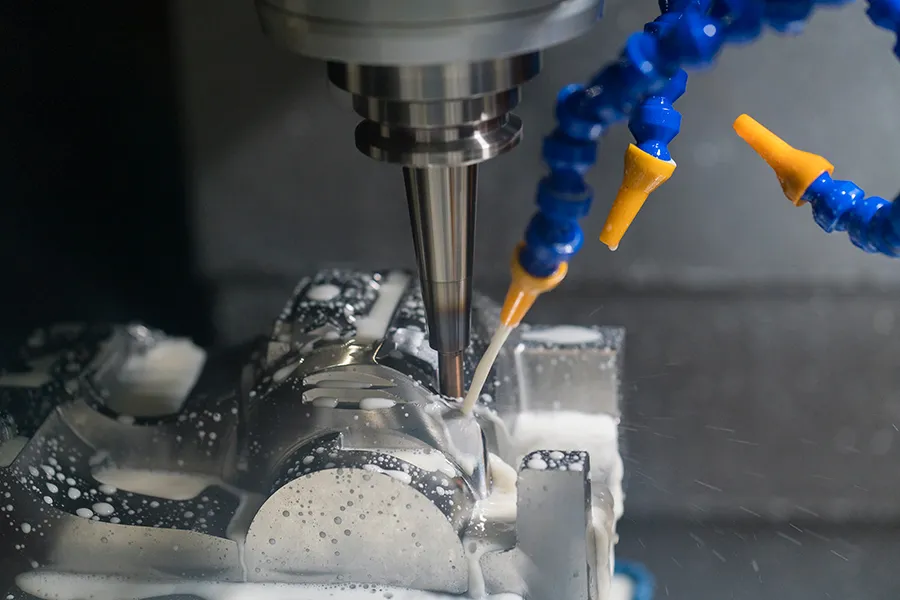9 Helpful Tips for CNC Milling Stainless Steel
CNC milling is a commonly used machining process for working with stainless steel. However, it’s important to note that stainless steel is a challenging material to machine due to its hardness and high thermal conductivity. Here are some considerations and tips when CNC milling stainless steel:
- Tool Selection: Use carbide or high-speed steel (HSS) end mills with a sharp cutting edge. These materials can withstand the high temperatures generated during machining and maintain their cutting performance.
- Cutting Speed: Optimize the cutting speed based on the specific grade of stainless steel you are machining. Generally, lower cutting speeds are preferred for stainless steel to reduce heat buildup and extend tool life.
- Feed Rate: Use a moderate feed rate to maintain a consistent chip load. Too low of a feed rate can cause rubbing, while too high of a feed rate can lead to premature tool wear.
- Coolant/Lubrication: Stainless steel generates a significant amount of heat during machining. It’s crucial to use an appropriate coolant or lubricant to cool the cutting tool and workpiece. This helps control heat buildup and improves chip evacuation.
- Rigidity and Stability: Ensure the CNC milling machine is properly calibrated and rigid to withstand the cutting forces involved in stainless steel machining. This helps minimize vibrations and ensures accurate and precise cuts.
- Chip Evacuation: Stainless steel tends to produce stringy chips that can interfere with the machining process. Implement effective chip evacuation techniques, such as using compressed air, chip breakers, or chip evacuation systems, to avoid chip accumulation and tool damage.
- Tool Path Strategy: Optimize the tool path to minimize the number of tool engagements and reduce the overall cutting time. Consider using climb milling for stainless steel to reduce tool deflection and achieve better surface finishes.
- Tool Cooling and Replacement: Keep a close eye on tool wear and temperature during the milling process. If necessary, interrupt machining to allow the tool to cool or replace it with a fresh one to maintain consistent performance.
- Post-Machining: After milling, remove any burrs or sharp edges using deburring techniques. Stainless steel can be prone to work hardening, so ensure that the final part meets the desired specifications and surface finish requirements.
It’s worth noting that the specific parameters and techniques may vary depending on the grade of stainless steel, the CNC machine capabilities, and the complexity of the part being milled. Always refer to the manufacturer’s recommendations and consult with experienced machinists for best results.
Stainless Steel Types
Stainless steel is a versatile and widely used material that comes in various types, often referred to as grades or alloys. The different types of stainless steel are classified based on their chemical composition, microstructure, and specific properties. Here are some commonly encountered types of stainless steel:
- Austenitic Stainless Steel (e.g., 304, 316): Austenitic stainless steel is the most common type and accounts for a significant portion of stainless steel production. It is characterized by its high corrosion resistance, good formability, and excellent weldability. Grade 304 (also known as 18-8 stainless steel) and grade 316 (containing molybdenum for improved corrosion resistance) are widely used in various industries.
- Ferritic Stainless Steel (e.g., 430, 446): Ferritic stainless steel has a higher chromium content and lower carbon content compared to austenitic stainless steel. It is magnetic and offers good corrosion resistance in certain environments. Ferritic stainless steel is often used in automotive applications, architectural trim, and appliances.
- Martensitic Stainless Steel (e.g., 410, 420, 440): Martensitic stainless steel is characterized by its high strength and hardness. It can be heat treated to achieve even greater hardness. While it offers less corrosion resistance compared to austenitic or ferritic stainless steel, it is commonly used in applications that require high mechanical properties, such as cutlery, surgical instruments, and turbine blades.
- Duplex Stainless Steel (e.g., 2205, 2507): Duplex stainless steel is a combination of austenitic and ferritic stainless steel, offering a balanced mix of properties. It exhibits high strength, good corrosion resistance, and improved resistance to stress corrosion cracking. Duplex stainless steel finds applications in chemical processing, oil and gas, and marine environments.
- Precipitation-Hardening Stainless Steel (e.g., 17-4 PH, 15-5 PH): Precipitation-hardening stainless steel is known for its excellent strength and hardness. These alloys can be heat treated to achieve even higher mechanical properties. They are used in industries such as aerospace, nuclear, and petrochemical, where high strength and corrosion resistance are required.
It’s important to note that within each type, there are multiple grades and variations of stainless steel, each designed to meet specific requirements and applications. The selection of the appropriate stainless steel type depends on factors such as corrosion resistance, mechanical properties, fabrication requirements, and cost considerations.
Search terms of this article:
milling stainless steel
milling steel
steel milling
steel cnc machiningsteel milling
steel milling service
stainless steel cnc milling
cnc stainless steel milling parts

